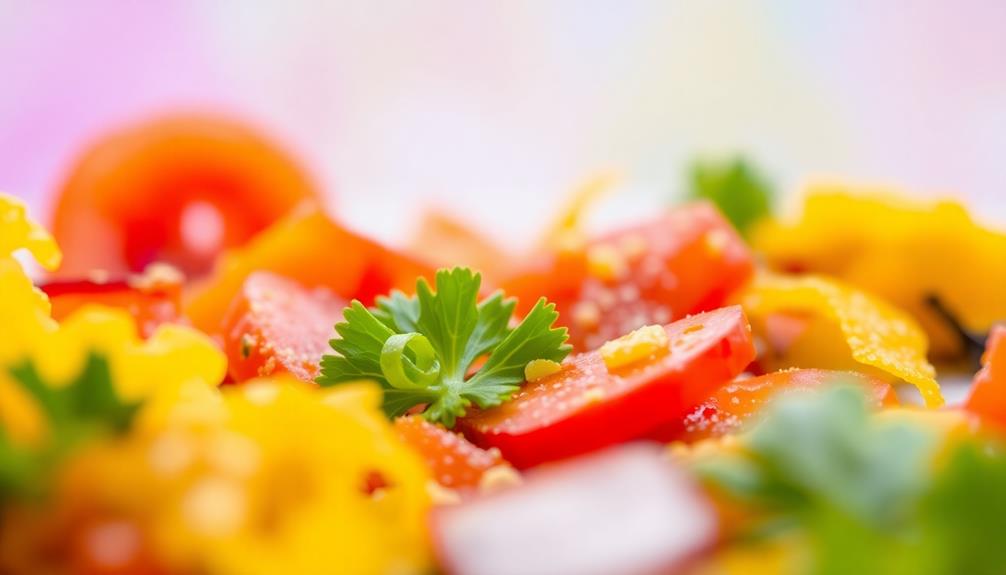Color vision affects your taste perception in surprising ways. The colors you see can influence your emotional reactions and expectations about food. For example, vibrant reds might lead you to expect sweetness. This means your brain can override what you're actually tasting based on visual cues. Oddly colored foods can trigger negative associations, making them less appealing or enjoyable. Additionally, younger individuals often rely more on these color-flavor associations, which can lead to misinterpretations. So, next time you sit down to eat, pay attention to how the colors on your plate might shape your experience—there's more to uncover about this fascinating connection.
Key Takeaways
- Color influences not only the emotional response to food but also expectations about its taste, affecting overall enjoyment.
- Bright colors, particularly red and orange, enhance perceived sweetness and richness, altering actual flavor perception.
- Unusual or off-colors can lead to avoidance due to associations with spoilage, impacting consumer choices.
- Younger individuals rely more heavily on color-flavor associations, making them more susceptible to misinterpretations of taste.
- Consistent and appealing color quality in food is essential for consumer acceptance and maintaining brand reputation.
Psychological Effects of Color

Color plays an essential role in shaping your emotional reactions and expectations about food. When you see vibrant reds or warm oranges, your mind often associates these colors with sweetness and richness, much like the deep hues found in dishes such as Red-Braised Pork Belly. This psychological impact can set the tone for your overall dining experience.
Studies show that brighter colors enhance your appetite and increase the appeal of food, influencing your perception of flavor before you even take a bite.
Visual cues from food colors can create preconceived notions about taste. For instance, when you see a yellow lemon, you're likely to expect a tart flavor. If the color doesn't match your expectations, it can lead to surprising taste experiences. Misleading colors can skew your perception, making you think a dish tastes different than intended.
These emotional responses to color highlight the importance of visual elements in your eating experience. The colors on your plate can override the actual flavor profiles, emphasizing that what you see can greatly impact what you taste.
Color and Flavor Associations

When you encounter food, the colors often trigger specific flavor associations that shape your expectations. Bright red, for instance, is commonly linked to perceived sweetness, influencing your taste perception even before you take a bite. This connection between color and flavor can greatly alter your experience, as visual cues set the stage for what you anticipate.
For example, a vibrant plate of Agnolotti might evoke richer flavor expectations than a more muted dish. Studies reveal that when food products appear in atypical colors, your ability to identify flavors can be thrown off, showcasing the power of color perception. Brighter colors tend to enhance perceived flavor intensity, making you rate your enjoyment higher. You might find that a vibrant green salad tastes fresher or more appealing than a dull one, thanks to these sensory properties.
Younger individuals often rely more heavily on color-flavor associations, leading to a greater chance of misinterpreting tastes. This reliance on color can create preconceived notions about how food will taste, affecting your overall experience.
Impact of Off-Coloring

In the world of food, off-coloring can drastically alter your perception and enjoyment. When you encounter a food product with an unexpected hue, several factors come into play that can affect your experience:
1. Consumer Avoidance: Unusual colors often trigger associations with spoilage, leading you to avoid the item altogether. This phenomenon can be particularly pronounced in traditional dishes, where color plays an essential role in cultural expectations and presentation.
For example, vibrant dishes like Caldeirada rely on their appealing colors to enhance the perception of freshness and flavor.
2. Flavor Perception: Research shows that artificial coloring can impair your ability to accurately identify flavors, making the food seem less appealing.
3. Visual Cues: You heavily rely on visual cues; when a food doesn't match your color expectations, it can distort your taste perception.
4. Product Failure: The infamous Crystal Pepsi is a prime example of how off-coloring can lead to product failure, as consumers were deterred by its unexpected appearance.
Maintaining consistent and appealing color quality is essential for consumer acceptance. When you see a vibrant, expected color, your taste buds are primed for enjoyment.
In contrast, off-coloring can create doubt and diminish the overall experience, impacting sales and brand reputation considerably. Understanding the importance of color in food can help you appreciate your meals more fully.
Research on Color Perception

Your perception of flavor isn't just about taste; it's heavily influenced by color as well. Research shows that color perception plays a crucial role in flavor identification. For example, under red lighting, 70% of participants accurately identified grape flavor, while only 20% did so under orange lighting. Cultural associations also shape how you perceive flavors; bright red foods often seem sweeter and less bitter than they truly are.
Color manipulation can have a striking impact on taste perception, especially in blind tests where colored foods received skewed flavor ratings. The following table illustrates these findings:
| Color | Associated Flavor | Taste Perception Impact |
|---|---|---|
| Red | Sweet | Higher ratings than actual |
| Orange | Tangy | Lower ratings than actual |
| Green | Bitter | Perceived as less bitter |
| Yellow | Sour | Often perceived as sweeter |
Younger individuals demonstrate a youthful reliance on color for flavor identification, making them more prone to errors tied to color cues. Ultimately, the context-dependent nature of color in food presentation underscores its significance in creating a multisensory experience.
Color Quality Control in Food

Color plays a vital role in food quality control, influencing consumer perceptions and choices. When you reflect on it, color quality directly affects how you perceive flavor intensity and overall appeal.
Interestingly, the vibrant colors of dishes like Yunnan Cross-Bridge Rice Noodles can enhance the overall dining experience by suggesting freshness and flavor. Here are some key aspects to take into account:
- Consumer Perception: The color of food markedly shapes your expectations and acceptance. Off-color foods can lead to negative judgments.
- Color Standards: Adhering to established color standards is essential in maintaining brand trust and marketability.
- Innovative Technologies: Advanced spectrophotometric evaluation techniques enable precise color analysis across various food forms, ensuring consistent quality.
- Real-Time Monitoring: Systems that monitor color in real time provide immediate alerts for any shifts, helping to prevent production losses.
Frequently Asked Questions
How Does Color Affect the Perception of Taste?
Color affects your perception of taste by shaping expectations. When you see vibrant hues, you might anticipate sweetness or freshness, while dull colors can evoke bitterness, altering your overall enjoyment and flavor recognition of foods.
What Can Affect Taste Perception?
Taste perception can be influenced by various factors, including aroma, texture, temperature, and visual cues. Your mood and past experiences also play roles, making each tasting experience unique and subjective.
How Does Visual Perception Affect Taste?
Visual perception shapes your taste experience greatly. When you see vibrant colors, you're likely to enjoy flavors more. Conversely, dull or mismatched colors can alter your expectations, impacting how you perceive the taste of food.
How Can Color Blindness Affects the Perception of Food?
When you can't distinguish colors, you might overlook ripe fruits or fresh vegetables, altering your culinary experiences. This misunderstanding can lead to missed flavors and a less satisfying relationship with food, affecting your overall enjoyment.
Conclusion
In exploring how color vision affects taste perception, it's clear that our senses are more intertwined than we might think. You may find it fascinating that studies suggest our brains can be tricked into tasting something differently based solely on color. This theory underlines the importance of color in food presentation and marketing, showing that the visual experience can greatly influence flavor perception. So, next time you eat, remember that color might just be influencing your taste buds more than you realize.









